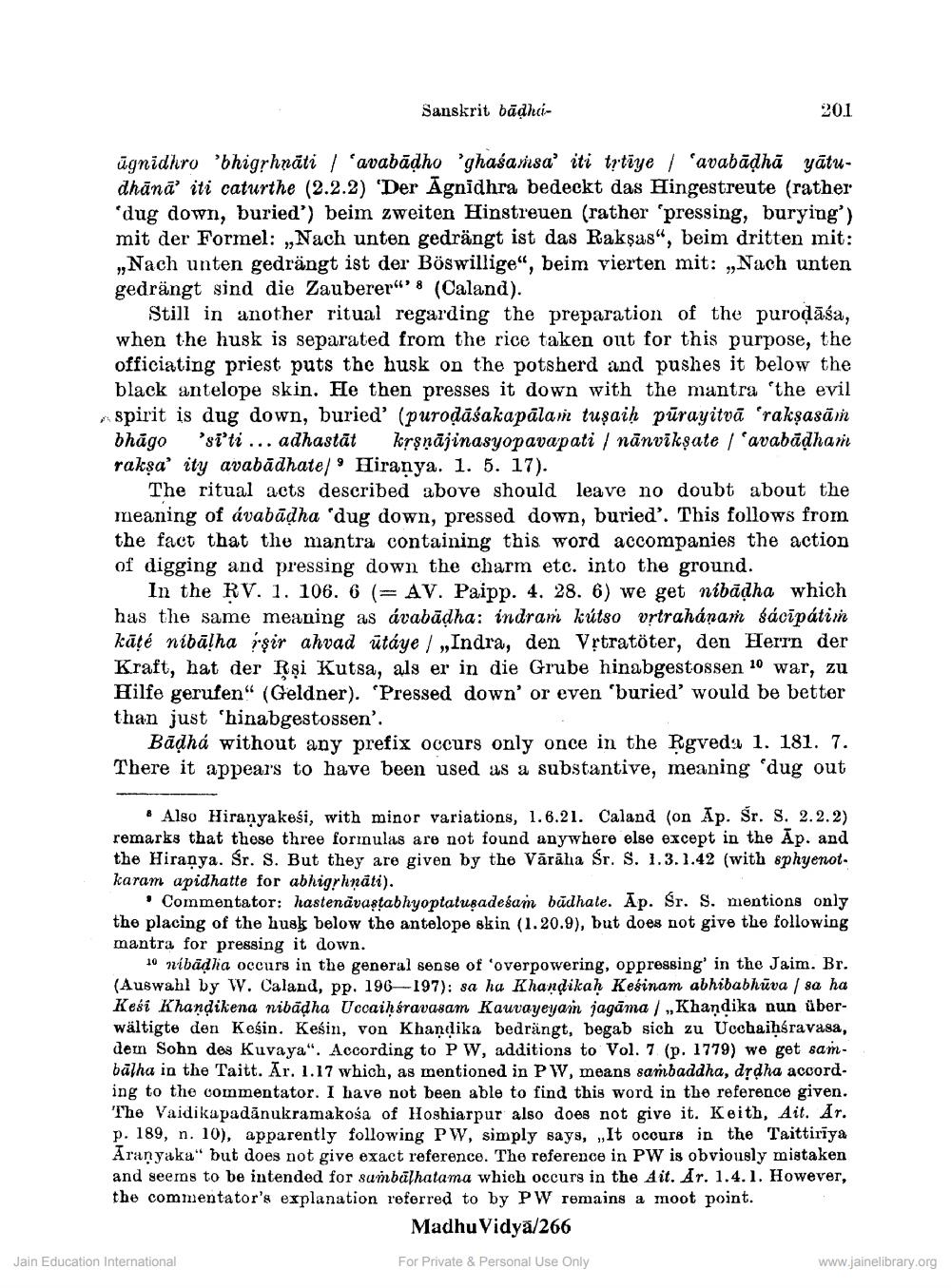________________
Sanskrit bādhi
20.1
ūgnidhro 'bhigyhnāti / 'avabādho 'ghasansa iti trtiye / 'avabādha yātudhānā iti caturthe (2.2.2) Der Agnidhra bedeckt das Hingestreute (rather dug down, buried') beim zweiten Hinstreuen (rather 'pressing, burying') mit der Formel: ,,Nach unten gedrängt ist das Rakşas“, beim dritten mit: ,,Nach unten gedrängt ist der Böswillige", beim vierten mit: „Nach unten gedrängt sind die Zauberer"8 (Caland).
Still in another ritual regarding the preparation of the purodāśa, when the husk is separated from the rice taken out for this purpose, the officiating priest puts the husk on the potsherd and pushes it below the black antelope skin. He then presses it down with the mantra 'the evil spirit is dug down, buried' (purodāsakapālam tuşaih pūrayitvā 'rakṣasān bhāgo 'siti ... adhastāt krşnājinasyopavapati / nānvikșate l'avabāờham raksa' ity avabādhate/' Hiranya. 1. 5. 17).
The ritual acts described above should leave no doubt about the meaning of ávabādha 'dug down, pressed down, buried'. This follows from the fact that the mantra containing this word accompanies the action of digging and pressing down the charm etc. into the ground.
In the RV. 1. 106. 6 (= AV. Paipp. 4. 28. 6) we get nibādha which has the same meaning as ávabādha: indram kútso vrtrahánan sácīpátinn kāté nibālha rșir ahvad ütáye / „Indra, den Vrtratöter, den Herrn der Kraft, hat der Rşi Kutsa, als er in die Grube hinabgestossen 10 war, zu Hilfe gerufen" (Geldner). Pressed down' or even 'buried' would be better than just 'hinabgestossen'.
Bāờhá without any prefix occurs only once in the Rgveda 1. 181. 7. There it appears to have been used as a substantive, meaning 'dug out
* Also Hiranyakesi, with minor variations, 1.6.21. Caland (on Ap. Sr. S. 2.2.2) remarks that these three formulas are not found anywhere else except in the Āp. and the Hiranya. Sr. S. But they are given by the Varaha Sr. S. 1.3.1.42 (with sphyenot. karam apidhatte for abhigyhnäti).
Commentator: hastenăvastabhyoptatusadeśam būdhale. Ap. Sr. S. mentions only the placing of the husk below the antelope skin (1.20.9), but does not give the following mantra for pressing it down.
10 zvíbādha occurs in the general sense of 'overpowering, oppressing' in the Jaim. Br. (Auswahl by W. Caland, pp. 196-197): sa ha Khandikah Kesinam abhibabhūva / sa ha Kesi Khandikena nibadha Uccaihśravasam Kauvayeyam jagāma / „Khandika nun überwältigte den Kesin. Kesin, von Khandika bedrängt, begab sich zu Ucchaihsravasa, der Sohn des Kuvaya". According to PW, additions to Vol. 7 (p. 1779) we get sambālha in the Taitt. Ar. 1.17 which, as mentioned in PW, means sambaddha, drdha according to the commentator. I have not been able to find this word in the reference given. The Vaidikapadãnukramakośa of Hoshiarpur also does not give it. Keith, Ait. Ar. p. 189, n. 10), apparently following PW, simply says, ,,It occurs in the Taittirīya Aranyaka" but does not give exact reference. The reference in PW is obviously mistaken and seems to be intended for sambalhatama which occurs in the Ait. Ar. 1.4.1. However, the commentator's explanation referred to by PW remains a moot point.
Madhu Vidya/266
Jain Education International
For Private & Personal Use Only
www.jainelibrary.org




